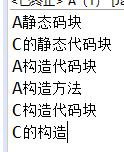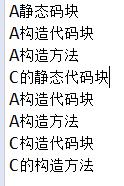父类静态(代码块,变量赋值二者按顺序执行)
子类静态
父类构造代码块
父类构造方法
子类构造代码块
子类构造方法
普通方法在实列调用的时候执行,肯定位于上面之后了
1 //父类A 2 public class A { 3 4 A() { 5 System.out.println("A构造方法"); 6 } 7 8 { 9 System.out.println("A构造代码块"); 10 } 11 12 static{ 13 System.out.println("A静态码块"); 14 } 15 16 public static void main(String[] args) { 17 C c1=new C(); 18 }
//子类C public class C extends A { static { System.out.println("C的静态代码块"); } { System.out.println("C构造代码块"); } C() { System.out.println("C的构造方法"); } }
结果:

这样就很明了了,下面稍微扩展一下,如果在main中出现 new A()呢?我们来看
1 //父类A 2 public class A { 3 4 static{ 5 System.out.println("A静态码块"); 6 } 7 8 A() { 9 System.out.println("A构造方法"); 10 } 11 12 { 13 System.out.println("A构造代码块"); 14 } 15 public static void main(String[] args) { 16 A a=new A(); 17 C c1=new C(); 18 }
//子类C public class C extends A { static { System.out.println("C的静态代码块"); } { System.out.println("C构造代码块"); } C() { System.out.println("C的构造方法"); } }
结果:

结果先执行完父类A,只执行子类C,并不是执行完A的静态就执行C的静态,这里可能有误区。
博主实测,欢迎指正。